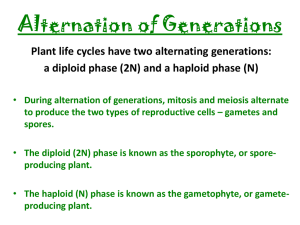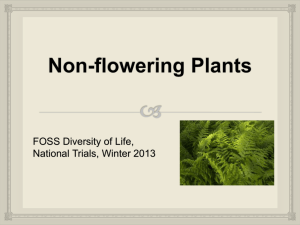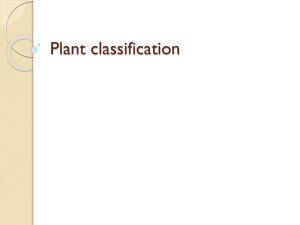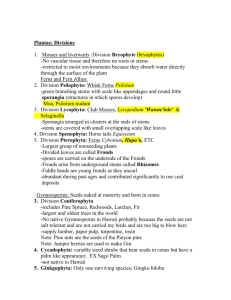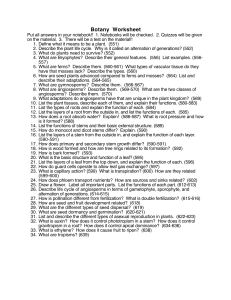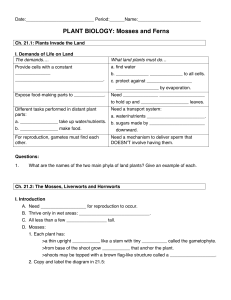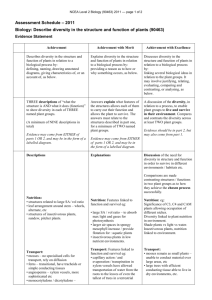Biology 2201 Test
advertisement
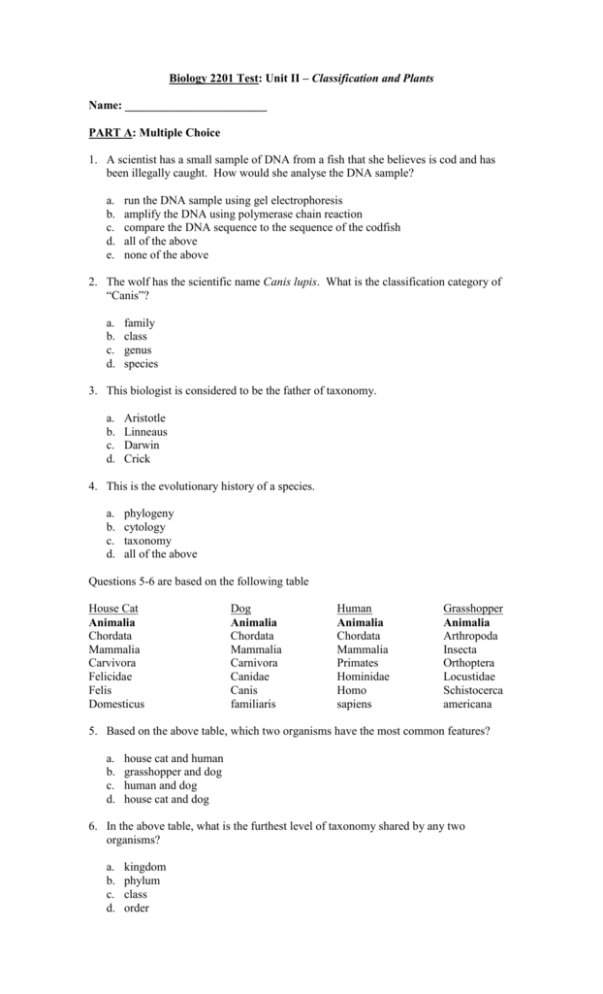
Biology 2201 Test: Unit II – Classification and Plants Name: ________________________ PART A: Multiple Choice 1. A scientist has a small sample of DNA from a fish that she believes is cod and has been illegally caught. How would she analyse the DNA sample? a. b. c. d. e. run the DNA sample using gel electrophoresis amplify the DNA using polymerase chain reaction compare the DNA sequence to the sequence of the codfish all of the above none of the above 2. The wolf has the scientific name Canis lupis. What is the classification category of “Canis”? a. b. c. d. family class genus species 3. This biologist is considered to be the father of taxonomy. a. b. c. d. Aristotle Linneaus Darwin Crick 4. This is the evolutionary history of a species. a. b. c. d. phylogeny cytology taxonomy all of the above Questions 5-6 are based on the following table House Cat Animalia Chordata Mammalia Carvivora Felicidae Felis Domesticus Dog Animalia Chordata Mammalia Carnivora Canidae Canis familiaris Human Animalia Chordata Mammalia Primates Hominidae Homo sapiens Grasshopper Animalia Arthropoda Insecta Orthoptera Locustidae Schistocerca americana 5. Based on the above table, which two organisms have the most common features? a. b. c. d. house cat and human grasshopper and dog human and dog house cat and dog 6. In the above table, what is the furthest level of taxonomy shared by any two organisms? a. b. c. d. kingdom phylum class order 7. Biologists discover a new organism. Upon viewing the organism, they discover it is unicellular, with a nucleus and a cell wall. To which kingdom does this new creature belong? (a) animalia (b) monera (c) plantae (d) protista 8. E. coli is a bacteria and belongs to the kingdom Monera. What can be inferred about E. coli based on this classification? a. b. c. d. E. coli is not harmful to humans E. coli has membrane bound organelles E. coli has a nucleus E. coli has no nucleus 9. Which of the following is a difference between bacteria and archaea? a. Archaea are unicellular, and bacteria are colonial. b. They have different chemicals in their cell membranes and cell walls. c. Bacteria are autotrophic, and archaea are heterotrophic. d. They look very different under a microscope. 10. Which of the following is NOT an example of a protist? a. b. c. d. dinoflagellate euglena halophile diatom 11. Bacteria that live around deep-sea, hot-water vents obtain energy by oxidizing inorganic hydrogen sulfide belched out by the vents. They use this energy to build organic molecules from carbon obtained from the carbon dioxide in the seawater. These bacteria might be described as a. photoheterotrophs. b. chemoautotrophs. c. photoautotrophs. d. chemoheterotrophs. 12. Which pair of plants are restricted to wet environments for sexual reproduction? a. b. c. d. angiosperms and gymnosperms ferns and gymnosperms ferns and mosses mosses and angiosperms 13. A botanist discovers a new species of plant in the tropical rain forest. After observing its anatomy and life cycle, the following characteristics are noted: xylem and phloem, separate gametophyte and sporophyte generations, and no seeds. To what classification is this plant most closely related? a. b. c. d. conifers ferns flowering plants mosses 14. Which category would the bean plant fall? a. b. c. d. angiosperm bryophyte conifer gymnosperm 15. What is the evolutionary sequence of plants from the most simple to the most complex? a. b. c. d. angiosperms, ferns, gymnosperms, mosses ferns, mosses, angiosperms, gymnosperms gymnosperms, angiosperms, mosses and ferns mosses, ferns, gymnosperms, angiosperms 16. What evolutionary trend is associated with higher plants? a. b. c. d. sperm in reproduction usually swims in water to the egg. Spores are the most common method of reproduction The gametophyte generation is dominant There is a decrease in the dependency on water for reproduction 17. Which of the following transports water ands minerals up the stem of the plant to the leaves? a. b. c. d. rhizoids xylem phloem bryophytes 18. This is a seed leaf and is important in nourishment for the embryo and germination. a. b. c. d. monocot cotyledon dicot spores 19. Which plant listed below could be classified as a bryophyte? a. b. c. d. lichen moss fern club moss 20. Members of the genus Selanginella are vascular plants that reproduce by the way of spores in the dominant generation. To what group would these be classified? a. b. c. d. bryophytes angiosperms algae fern and fern allies 21. Which of the following would not be used as characteristics to identify different plant groups? a. b. c. d. presence of vascular tissue reproduction by seeds reproduction by spores presence of chlorophyll 22. The seed of a gymnosperm lacks which of the following? a. seed coat b. embryo c. fruit d. food supply 23. In the life cycle of a gymnosperm, which is the correct series of events: a. fertilization, pollination, young sporophyte, seeds released from cone b. pollination, fertilization, seeds released from cone, young sporophyte c. seeds released from cone, fertilization, young sporophyte, pollination d. seeds released from cone, pollination, young sporophyte, fertilization 24. The cells from the sporophyte generation are: a. monoploid spores b. diploid spores c. triploid spores d. polyploid spores 25. Which is true of conifers but not of ferns? A. They have vascular tissue. B. The embryo is protected by a seed. C. They carry on photosynthesis. D. The leaves have a waxy layer of cutin. ANSWER SHEET Name: ________________________ 1. _____ 10. _____ 19. _____ 2. _____ 11. _____ 20. _____ 3. _____ 12. _____ 21. _____ 4. _____ 13. _____ 22. _____ 5. _____ 14. _____ 23. _____ 6. _____ 15. _____ 24. _____ 7. _____ 16. _____ 25. _____ 8. _____ 17. _____ 9. _____ 18. _____ PART B: Short Answer Questions (25 marks total) 1. Scientists now use a wide variety of information to classify organisms. Outline any four (4) of these types of information by a using a description and providing an example to illustrate. You may use a table (8 marks) 2. Some people believe that it is possible that the Beothuck Indians may have amalgamated into the European population that settled in Newfoundland. How would you prove or disprove this claim? (2 marks) 3. Scientists recently moved from using a five kingdom system of classification to a six kingdom system of classification. What recent advancements allowed scientists to discover more about classification to make this change? (2 marks) 4. Why it is important to classify organisms. (1 mark) 5. Explain why seeds can be referred to as “plants in storage” while spores can not. (2 marks) 6. Compare/contrast the adaptations for life on land between bryophytes and tracheophytes. (6 marks) 7. Give four (4) reasons to explain why angiosperms are the most dominant and diverse plant form on earth. (4 marks)

